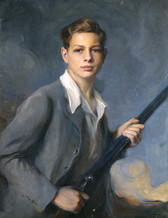Philip de László - Gifted Gallery
- Lilium
- Aug 24, 2022
- 4 min read

Philip Alexius de László MVO RBA, born 30 April 1869, was an Anglo-Hungarian painter known particularly for his portraits of royal and aristocratic personages. In 1900, he married Lucy Guinness of Stillorgan, County Dublin, and he became a British subject in 1914.
László was born in Budapest as Fülöp Laub, the eldest son of Adolf and Johanna Laub, a tailor and seamstress of Jewish origin. Philip and his younger brother Marczi changed their surname to László in 1891.
From the age of ten he was employed by a scene-painter and was apprenticed to a photographer while studying art, eventually earning a place at the National Academy of Art, where he studied under Bertalan Székely and Károly Lotz. At the age of fifteen in 1884 he began studying art at the School of Applied Arts in Budapest. He graduated to the Academy of Fine Arts two years later and in 1889-90 he moved to the Academy in Munich, following this with studies in Paris.
In late 1893 he met Elek Lippich, an official in the fine arts department of the ministry of education, who began to secure portrait commissions for the young artist, including several royal sitters, which would mark the beginning of his rapid rise as painter to the courts of Europe.
De László regularly exhibited work in the winter exhibitions held at the Hungarian Fine Arts Society in Budapest and from the mid-1890s portrait commissions proliferated, including the Hungarian prime minister Sándor Wekerle (1894) and the Emperor Franz Josef I (1898). Further success followed showings of his work at the Paris Salon and László's portrait of Pope Leo XIII earned him a Grand Gold Medal at the Paris International Exhibition in 1900.
In 1900, László married Lucy Madeleine Guinness, a member of the banking branch of the Guinness family and a sister of Henry Guinness. They had first met in Munich in 1892, but for some years had been forbidden to see each other. The couple had six children and 17 grandchildren.
In 1903, László moved from Budapest to Vienna. In 1907, he moved to England and remained based in London for the remainder of his life, although endlessly travelling the world to fulfil commissions.
László's patrons awarded him numerous honours and medals. In 1909, he was invested MVO by Edward VII. In 1912, he was ennobled by King Franz Joseph of Hungary; his surname then became "László de Lombos", but he soon was using the name "de László".
Despite his British citizenship, his marriage and five British citizen sons, de László was interned for over twelve months in 1917 and 1918 during the First World War, accused of making contact with the enemy (he had written letters to family members in Austria).

In May 1918, on account of his health, he was moved from Holloway Internment Camp to a nursing home in Ladbroke Gardens, Notting Hill, where he was kept under house arrest and allowed to see no-one but his wife and children. In December 1918, his solicitor Sir Charles Russell offered his country home, Littleworth Corner, at Burnham Beeches in Buckinghamshire to the artist and his family, where he was permitted by the Home Secretary to live on strict parole, not permitted to go more than three miles from the house.
Having been virtually deprived of the opportunity to paint or draw whilst interned, the period at Littleworth Corner between December 1918 and June 1919 was one of intense activity for de László, painting portraits and oil studies of his family. Those works count amongst the finest he ever painted of his wife and children. He was exonerated in June 1919.
During the 1920s and 1930s de László continued to work relentlessly; by his own calculation, he estimated he painted 2,700 portraits over the course of his career. These included members of the majority of royal houses of Europe, European political leaders, British aristocracy and establishment. He was elected president of the Royal Society of British Artists in 1930 and vice-president of the Royal Society of Arts in 1937. His work was part of the painting event in the art competition at the 1932 Summer Olympics.
Due to overwork, de László suffered heart problems for the last years of his life. In October 1937, he had a heart attack and died a month later at his home, Hyme House, in Hampstead, London, aged 68.

In 1939, Portrait of a Painter. The Authorized Life of Philip de László by Owen Rutter, written in conjunction with de László, was published. In 2010, Yale University Press published De László, His Life and Art by Duff Hart-Davis and Dr. Caroline Corbeau-Parsons. His reputation still remains largely as a society portrait painter, but well numbered amongst his sitters were industrialists and scientists, politicians and painters, men and women of letters and many other eminent, as well as ordinary people. Family members and a team of editors are compiling a catalogue raisonné published online and in progress. His oeuvre currently numbers almost 4,000 works, including drawings.
Reading Recommendations & Content Considerations
Philip de László His Life and Art
1869-1937 Duff Hart-Davies
















































































































































































































































































































































































































































































































































































Comments